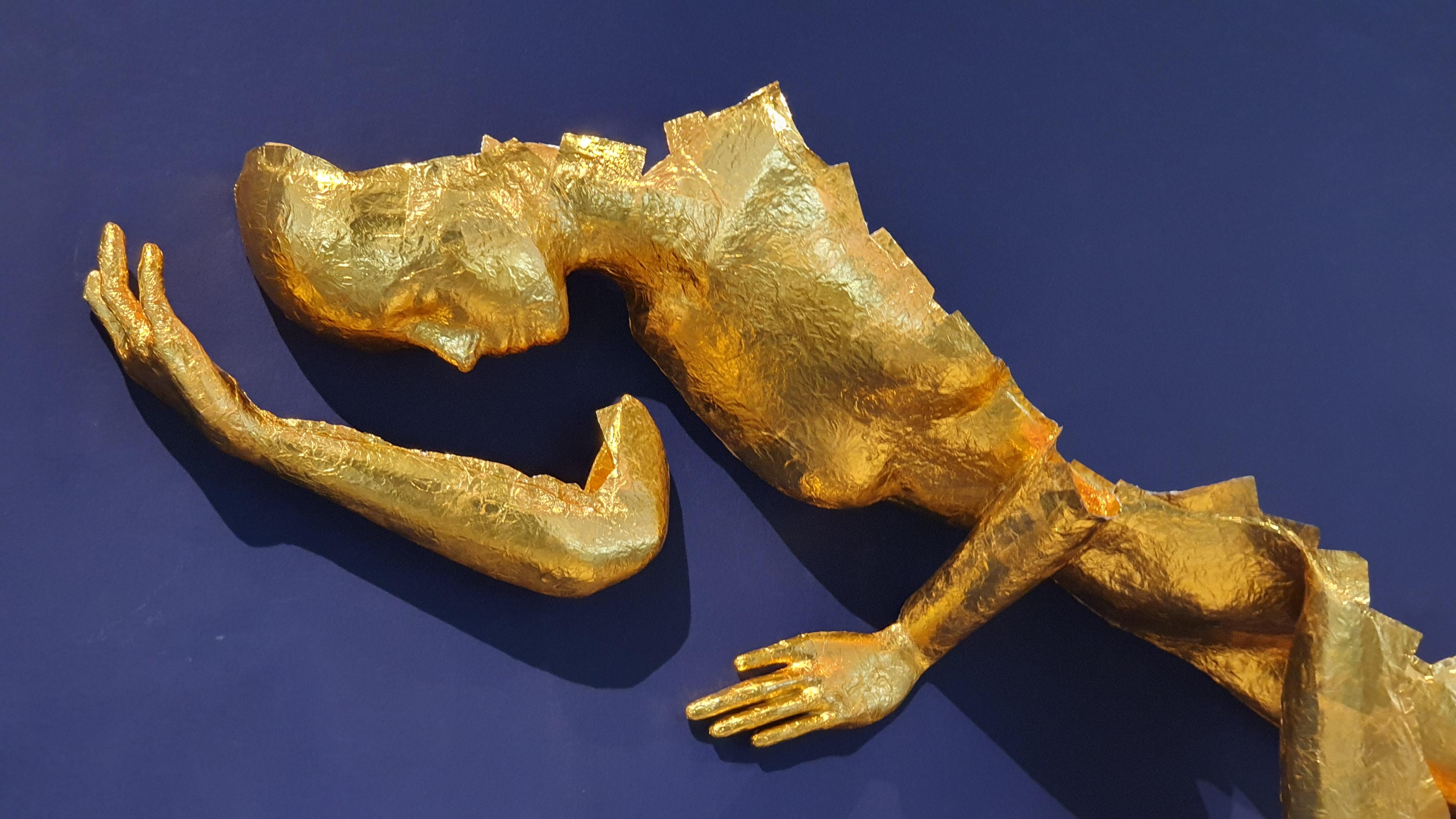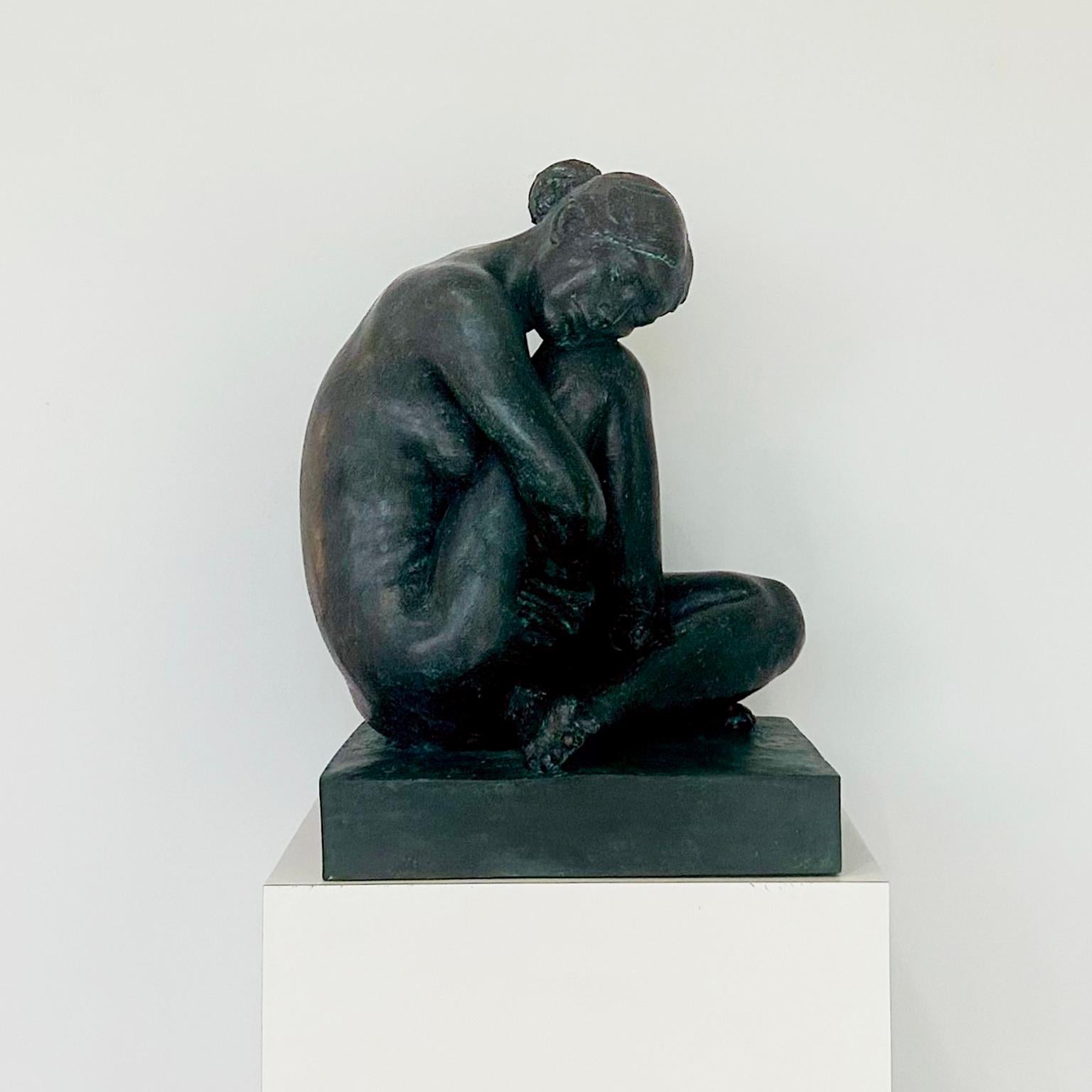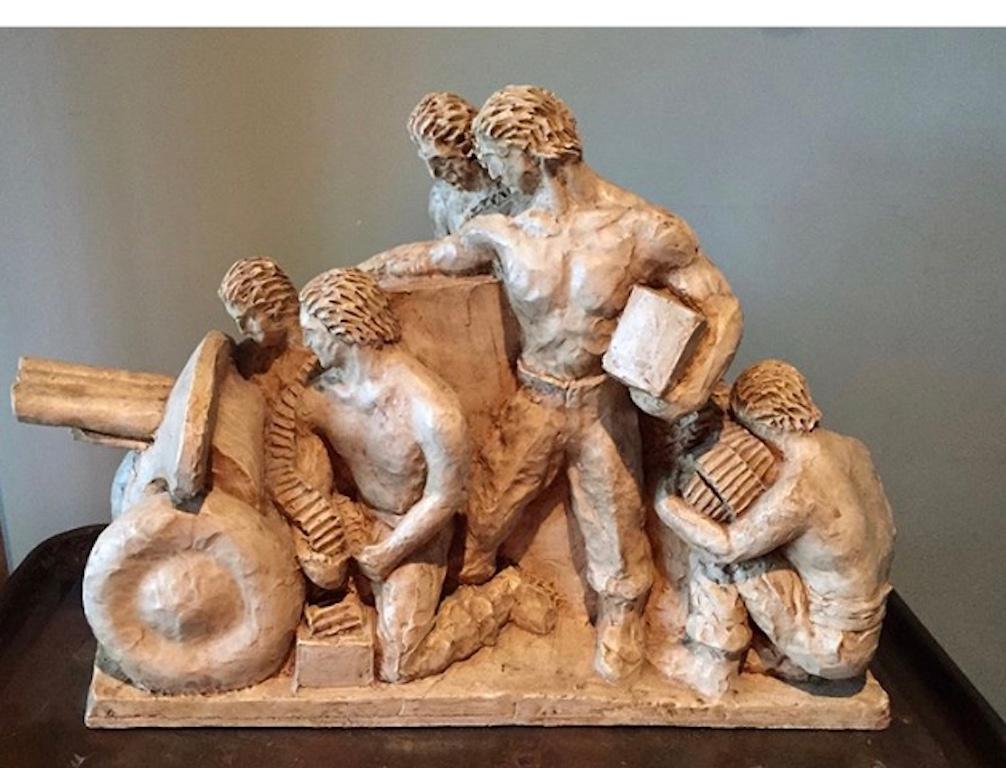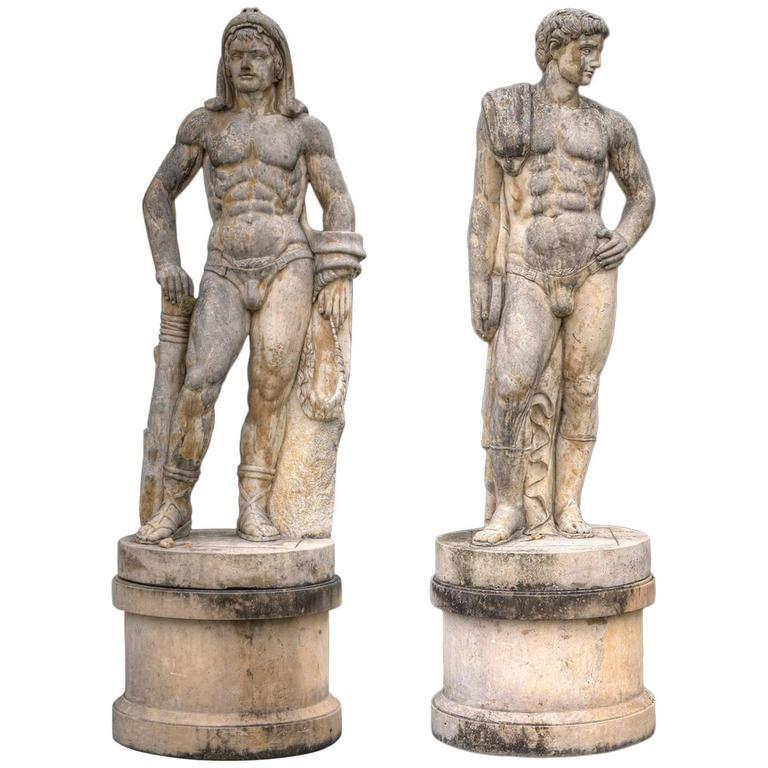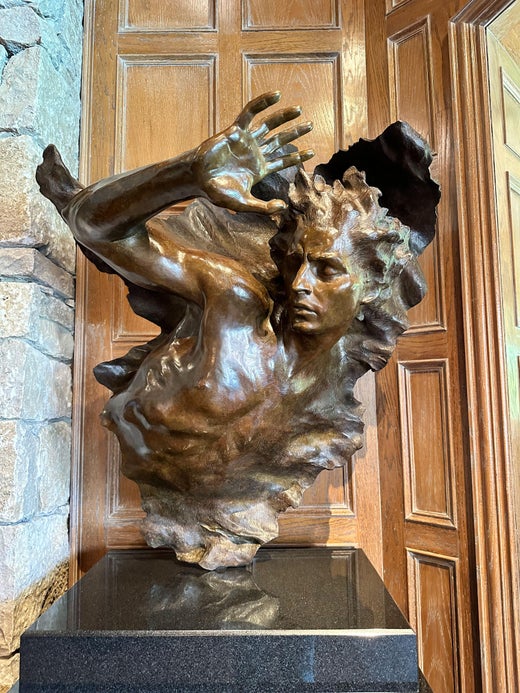Items Similar to Dance of Life
Video Loading
Want more images or videos?
Request additional images or videos from the seller
1 of 13
Frederick HartDance of Life1997
1997
About the Item
Frederick Hart (American, 1943-1999)
Dance of Life, 1997
Edition: 195/350 along base
Signed, dated along base
23.25 x 8.75 x 8.25 inches
Frederick Hart was a prominent late 20th century figurative sculptor. His view was that, "Art must touch our lives, our fears and cares; evoke our dreams and give hope to the darkness." He took the notion stated by playwright Tom Stoppard, who said "Modern art is innovation, without skill," and rejected this nihilism when developing the techniques that would earn him the title the "Rodin of our Century."
Beginning his life in Atlanta, and his career in Washington D.C., Hart was the epitome of the starving artist. He saw that he was spiritually descended by famed figurative masters such as August St. Gaudens and Daniel Chester French, but he failed to realize the fame these artists enjoyed. At Dupont Circle he could be found sculpting girlfriends, kids and buddies but not truly finding his calling. He became despondent with the lack of skill on the "modern" art scene, and more the notion that society had forgotten what it meant for something to be beautiful, timeless and everlasting.
Hart then discovered the Washington National Cathedral, the seventh largest cathedral in the world, and the only place in the world he could truly surround himself with the Italian master stone carvers that would make him the master. He carried tools, fetched coffee and finally ingratiated himself into the cadre of stone carvers, whose impermeable ranks were so hard to breach. The head master himself, Roger Morigi, a temperamental Italian, with a penchant for the "tough-love" way of teaching, took him as an apprentice.
In 1971, Hart found out about the competition for the commission of the sculpture to adorn the west facade of the cathedral with a sculpture based on creation. Hart inspired by the writings of Pierre Teilhard de Chardin a French Jesuit theologian and philosopher who said that mankind is in a constant state of becoming conscious of itself. With this thought in mind he spent two and one-half years creating what became one of the most prominent religious sculpture of our day. Ex Nihilo (Out of Nothing), an eight figure larger than life swirling mass, which notoriously gained recent recognition as the subject of the lawsuit against the makers of the movie The Devil's Advocate, which Hart won. The sculpture was thirteen years in stone carving, and finally dedicated in 1982.
Hart created the six major sculptures on the West facade, giving him a similar historical place among masters such as Bernini, Michaelangelo and Rodin. Hart said, upon it's completion "my life's work is complete, my destiny fulfilled." Once complete Hart looked through the art journals and literary magazines for some mention of this masterwork, none came. Hart hoped he would find an article panning it, just to let him know that someone was watching figurative work. No one was.
Hart decided his sculpture was ignored because it was in the tradition of the old school, and therefore offered no new ideas. During this cycle, Hart heard about a commission to be awarded for the dedication of a new "Vietnam Veterans Memorial" to be placed on the Mall in front of the Washington Monument. The requisite element was that all 58,000 dead must be named. Hart entered a sculpture containing both a wall with the listed dead, as well as a medic running toward a wounded soldier. The board voting on the monument awarded the commission to a 21-year-old Yale University architecture student, Maya Ying Lin. Lin's design was a minimalist black granite wall, shiny, deeply cut into the Earth. This set off a series of debates that occupied the United States with bitter debate. The problem that veterans (and Hart) had with it was that it lacked a human face. How would such a wall translate to a society one hundred years from now? Once we are dead and gone, would it still have any impact, like the sculptures of civil war heroes? Vets called it the "great black gash of shame and sorrow." Hart simply called it "a telephone book listing of dead people".
Funding for the project was withheld until a suitable solution could be reached. The idea was proposed that a figurative element be placed near the monument, at its apex. Hart was given the commission, and altered the plan. Instead of placing his Three Servicemen at the apex, place them approximately 400 feet from the wall; looking, as one Vet said "for their own names." This satisfied both sides and quelled the debate.
In an interview, Hart mentioned that the monument is one of the hardest places for him to visit, because after absorbing all of the interviews with GI's, and the controversy surrounding the monument itself, he had to synthesize it into what it became, in his words "the most effective ensemble monument in the United States."
In the early 70's, after sculpting in stone (the stone age) and bronze (the bronze age), Hart turned his attention to light. He believed we were entering an age of enlightenment, "The age of Light". So he began developing the uses of clear acrylic resin, to "Sculpt in light". Harking back to the teachings of Chardin, and his vision of creation, Hart created a new legacy with his development of acrylic as a figurative media. The Children of Ex Nihilo were born. After releasing his first sculpture in the "Age of Light" collection, in 1984, Hart's vision became clearer and he began to realize the artistic and commercial success of his work.
Subsequent works, such as Memoir and Dance of Life experimented with imbedding one acrylic sculpture within another, which Hart then patented. The mystery of this technique still confounds viewers and technicians to this day. Through commercial success and public monuments, works for Pope John Paul II such as Cross of the Millennium, Hart still surprisingly enjoyed little critical acclaim.
On August 13, 1999 at the age of 55, Hart died of lung cancer that was diagnosed only two days before.
- Creator:Frederick Hart (1943 - 1999, American)
- Creation Year:1997
- Dimensions:Height: 23.25 in (59.06 cm)Width: 8.75 in (22.23 cm)Depth: 8.25 in (20.96 cm)
- Medium:
- Movement & Style:
- Period:
- Condition:
- Gallery Location:Missouri, MO
- Reference Number:1stDibs: LU747314276522
Frederick Hart
A sculptor and stone cutter in the Classical* style, Frederick Hart was an apprentice at the National Cathedral in Washington DC and there learned about sculpting and stone cutting. Then his big break of public recognition came when he won a competition to design the facade of the Cathedral, which incorporated his thirteen year masterpiece of the Creation, a 21 X 15 foot bas relief*. He also designed Three Soldiers, realistic in style, for the Vietnam Veteran's Memorial in DC to contrast with the abstraction of Maya Lin's Vietnam Memorial. Born in Atlanta, Georgia and raised in South Carolina, Frederick Hart was an opponent of most contemporary art, thinking it motivated by political rather than aesthetic reasons. As a proponent of Realism*, he was made an honorary member of The American Society of Classical Realism Guild of Artists. Just before his premature death from lung cancer in 1999, he built his 17,000 square-foot dream home "Chesley," on 250 acres of land in Virginia. This mansion was intended to be an artists' retreat to nourish traditional, classical values and refute modernist* trends that he said allowed anything to be called art. He endured several legal battles including the use of his Three Soldiers on a souvenir without his permission and a lawsuit with Time-Warner over the "demonizing" of his creation scene.
About the Seller
5.0
Vetted Seller
These experienced sellers undergo a comprehensive evaluation by our team of in-house experts.
Established in 1970
1stDibs seller since 2017
142 sales on 1stDibs
Typical response time: 22 hours
- ShippingRetrieving quote...Ships From: Missouri, MO
- Return PolicyA return for this item may be initiated within 2 days of delivery.
More From This SellerView All
- En ReposeBy Ermanno NasonLocated in Missouri, MOErmanno Nason (Italian, b. 1928) Reclining Figure, 1978 18 x 8.5 inches Smoke Glass Signed and dated along base Ermanno Nason was born on July 21st, 1928 on Murano. He belonged to o...Category
1970s Modern Figurative Sculptures
MaterialsGlass, Blown Glass
- Falling Man, 1990By Ernest Tino TrovaLocated in Missouri, MOFalling Man, 1990 By. Ernest Trova (1927-2009) 6.5" x 2" x 2" Ed. 50/99 Numbered/Dated on Bottom *This figure has multiple moving sections Known for his...Category
20th Century Abstract Figurative Sculptures
MaterialsStainless Steel
- The EncounterBy Ernest TrovaLocated in Missouri, MOErnest Trova "The Encounter" 1994 Chrome Plated Steel Approx 24 x 26 x 24 inches Edition 1/8 Known for his Falling Man series in abstract figural sculpture, he created hard-edge ima...Category
1990s American Modern Figurative Sculptures
MaterialsStainless Steel
- Yan Black HeadbandBy Pablo PicassoLocated in Missouri, MO"Yan Black Headband" (A.R. 514) 1963 Red Earthenware Pitcher Painted in Black Inscised 'EDITION PICASSO MADOURA' and 'EDITION PICASSO' pottery stamps on...Category
1960s Modern Figurative Sculptures
MaterialsCeramic
- Joie de VivreBy Pablo PicassoLocated in Missouri, MOJOIE DE VIVRE (A. Ramié no. 346) stamped, marked, engraved and numbered 'Madoura Plein Feu/Empreinte Originale de Picasso (underneath) unglazed white ea...Category
1950s Modern Figurative Sculptures
MaterialsCeramic
- Frog and Swiss on RyeBy David GilhoolyLocated in Missouri, MOFrog and Swiss on Rye, 1981 By David Gilhooly (1943-2013) 4.75" x 3.5" x 4.5" Whimsical and irreverent, Mr. Gilhooly was internationally acclaimed for his imaginative ceramic works...Category
20th Century American Modern Figurative Sculptures
MaterialsCeramic
You May Also Like
- Dana Bloom, Measurement, Currently presented at the Tel Aviv BiennaleLocated in Tel Aviv, ILDana Bloom's Measurement features a gilded human figure that challenges the viewers' perception of presence and absence, while exuding a dreamlike, timeless...Category
2010s Contemporary Figurative Sculptures
MaterialsFoil, Gold Leaf
- "Untitled" bronze sculpture of seated female figure by artist Felipe CastañedaBy Felipe CastañedaLocated in Boca Raton, FL"Untitled" bronze sculpture of a female nude by artist Felipe Castañeda. Inscribed F. Castañeda 1984 P/A on base.Category
1980s Modern Figurative Sculptures
MaterialsBronze
- "Pioneer Family" WPA American Modernism Plaster Maquette Realism 20th CenturyBy William ZorachLocated in New York, NY"Pioneer Family," 23 1/2 x 16 1/4 x 10 3/4 inPlaster. c. 1927. Unsigned. Realism The Smithsonian has a cast of this sculpture in its collection. Pictured on the cover of “The Sculpt...Category
1920s American Modern Figurative Sculptures
MaterialsPlaster
- Industrial Machine Age American Scene WPA Mid 20th Century 1939 SF World's FairLocated in New York, NYIndustrial Machine Age American Scene WPA Mid 20th Century 1939 SF World's Fair HAIG PATIGIAN (American/Armenian, 1876-1950) Aeronautics Pediments Two Plaster Casts, c. 1930s each 13.25 x 14.75 x 6 inches It's possible these moquettes were created for the 1939 World's Fair, the Golden Gate International Exhibition in San Francisco. Provenance: Private Collection of Lois M. Wright, Author of "A Catalogue of the Life Works of Haig Patigian, San Francisco Sculptor, 1876-1950),” 1967 Loan to Oakland Museum of California (Oakland, CA) BIO Haig Patigian is noted for his classical works, which are especially numerous in public venues in San Francisco, California. Patigian was born in Van, Armenia, which at that time was under Turkish rule. Haig was the son of Avedis and Marine Patigian, both teachers in the American Mission School there. He and his older brother showed an aptitude for art early on and were encouraged by their parents. Their father himself had taken up the new hobby of photography. The 1880s were harsh times, however, for many Armenians under an oppressive rule by the Turkish government. Many people were fleeing to the safety of the United States. Suspicious Turkish authorities accused his father of photographing city structures for the Russian government, and in 1888 he fled for his life to America. Haigs father made his way to Fresno, California, and began life anew as a ranch hand. Within two years he sent for his wife, as well as Haig, his three sisters and brother, and in 1891 the Patigians made the journey from Armenia. Haigs father, an industrious man, worked on various farms, and eventually bought his own ranch and vineyard. It was among fertile farmland of Fresno that Haig grew up. Young Haigs education consisted of teachings by his parents and by intermittent attendance in public schools. Although he had dreams of becoming an artist, he did not have the opportunity for formal study of art, and began working long days in the vineyards around Fresno. At age seventeen, Haig made a step towards his dreams and apprenticed himself to learn the trade of sign painting. In his spare time he nurtured his interest in art by painting nature and life scenes with watercolors and oil paints. When his sign-painting mentor left Fresno, Haig opened his own shop and made a name for himself in the town. San Francisco, in the meantime, had been attracting artists since the Gold Rush and had become a thriving art center. Within a few years, Haig had put aside several hundred dollars to move to San Francisco, joining his brother who was already working there as an illustrator. In 1899, when he was twenty-three, Haig had saved enough money to enroll at the Mark Hopkins Art Institute in San Francisco. Like many aspiring artists of his time, Patigian supported himself by working as a staff artist in the art department of a local newspaper, and in the winter of 1900, nearing his 24th birthday, Haig began work for the San Francisco Bulletin, producing cartoons, black and white illustrations, as well as watercolors. In 1902 tragedy struck Haig and his family. His 29-year-old brother died of pneumonia, and then his frail mother died a short time later. Five months more saw his youngest sister, just out of high school, die too. Saddened and depressed, Haig moved out of the studio he had shared with his brother, and into a dilapidated studio in a poor section of town. During this time of sadness, Haig fed a growing interest in sculpture. In 1904 Haig created what he later called his "first finished piece in sculpture". The work, called "The Unquiet Soul", depicted a man thrown back against a rock while waves lash at his feet. The body was tense and twisted, with one hand, in Haig's own words, "searchingly leaning and clutching the rock, while the other masks his troubled head". The Press Club of San Francisco, which Haig had joined in 1901, put "The Unquiet Soul" on exhibition and local headlines proclaimed "Local Newspaper Artist Embraces Sculptor's Art", and "First Work Predicts Brilliant Future". With the support of friends and community acclaim, the young illustrator left his newspaper job and became a professional sculptor. The path of his new career was not easy though. Haig had never made much money working for the newspaper and his father needed help with growing debt from funeral expenses and business problems. From time to time Haig sold some artwork, but also occasionally borrowed from friends to pay the rent. He was the classic 'starving artist'. In the spring of 1905 a white-bearded 81-year-old stranger knocked on Haig's door. It was George Zehndner, from Arcata, California. Zehndner had been born in Bavaria, Germany in 1824, the son of a farmer. In 1849 he had come to America looking for prosperity, settling in Indiana, where he worked on a farm and learned English. He found his way to the West Coast in 1852. Penniless, he worked in various jobs from San Francisco to Sacramento, then found some luck working in the gold fields of Weaverville in Trinity County, and eventually moving to a farm on 188 acres near Arcata. In his 77th year in May of 1901, Zahndner had taken a trip to San Jose, where he stood in a crowd to see a man he thought much of, President William McKinley. McKinley was popular as 'the first modern president' partially because he realized going out to meet the common person increased his support. In September of that year, however, an anarchist assassinated the president while he stood in a receiving line at the Pan-American Exhibition in Buffalo, New York. Soon after, the city of San Jose erected a statue of the slain president in St. James Park. Zehndner took a second trip to San Jose where he visited the McKinley monument. Touched, Zehndner decided that, no matter the cost, his town of Arcata too would memorialize McKinley. George Zehndner had read about Haig in a newspaper article and asked if Patigian would create a heroic statue of the late President McKinley for Arcata. When asked how much it would cost, Haig responded, despite his borderline poverty, with the fabulous sum of $15,000. Zehndner agreed. The President was to be portrayed standing, wearing an overcoat, with his feet planted squarely on the ground. In the finished statue, one hand is held out before him in a typical posture of speaking, with the other hand holding the speech as his side. The 9-foot statue...Category
1930s American Modern Figurative Sculptures
MaterialsPlaster
- 2 Sculptures: "The Power" & "The Glory" WPA Depression WWII era mid 20th centuryBy Agnes YarnallLocated in New York, NY2 Sculptures: "The Power" & "The Glory" WPA Depression WWII era mid 20th century by Agnes Yarnall circa 1940s. Sculptor, painter, poet and artistic historian, Agnes Yarnall has, since the age of six been breathing life into her art. Renowned as a sculptor, whose commissioned portrayals of contemporary celebrities are prized. She has sculpted Judith Anderson, Edna St. Vincent Millay, Carl Sandburg...Category
1940s American Modern Figurative Sculptures
MaterialsPlaster
- Monumental Marble Italian Rationalist Figurative Nude SculpturesLocated in Rome, ITThis monumental pair of sculptures in "Bardiglio" marble represent Greek Athlete of Discobolo and the Hercules figure with a lion pelt, on a cylindrical ...Category
1960s Modern Figurative Sculptures
MaterialsMarble
Recently Viewed
View AllMore Ways To Browse
Old Vintage Saws
Pope Vintage
1984 Watches
Acrylic Sculpture Italian Modern
Watch Children Sign
Cross Watch
Modern Shiny Sculpture
Enlightenment Sculpture
Vintage Architecture Tools
Large Stone Head Sculpture
Pan Sculpture
Vintage Inspired Watch
Dior Altered
Vintage Book Journal
Frederick Ii
Sculpture Pope
Clear Vintage Watch
Alter Watch
